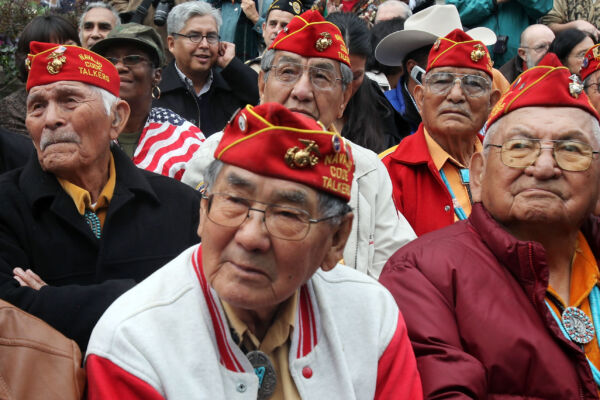During World War II, the US Marine Corps used the special language of the indigenous Navajo people as a code and recruited Navajo tribe members to serve as “code talkers.” These warriors lived up to expectations and ultimately helped the US military achieve victory in the Pacific theater. Last Saturday, October 19th, WWII veteran John Kinsel, who had participated in this top-secret program, peacefully passed away at the age of 107 in his home, prompting deep condolences from various sectors of American society.
The Navajo tribe is the largest Native American tribe in the United States, primarily residing in the southwestern states of Arizona, New Mexico, Utah, and Colorado. Their tribal culture is rich, and the grammar of the Navajo language they use is complex, with a wide variety of phonetics and dialects vastly different from other indigenous language families. Without extensive exposure and learning, outsiders simply cannot comprehend its meaning.
After recognizing the immense potential of using the Navajo language as a military code, the US military first recruited 29 Navajo tribe members to create this code and undergo special training. They transmitted these Navajo language-encoded codes via radio to relay Japanese troop movements, locations, and other crucial battlefield information, and this communication code remained unbroken by the Japanese military until the end of World War II.
It is reported that around 400 Navajo code talkers served during WWII, and John Kinsel Sr., who recently passed away, was part of the second group of code talkers who volunteered to enlist. The contributions of these brave warriors to the US military during WWII were immeasurable. The Hollywood war film “Windtalkers,” released in 2002 and translated in Taiwan as “Operation Windtalker,” was based on their true story.
Furthermore, they received numerous awards from US presidents, including President Reagan declaring August 14th as “Navajo Code Talkers Day” in 1982, and President Bush presenting the original 29 Navajo code warfighters with Congressional Gold Medals in 2001.
Born in Cove, Arizona, John Kinsel Sr. joined the US Marine Corps in October 1942 and became a skilled code communicator. He participated in multiple battles including Guadalcanal, Bougainville Island, Guam, and Iwo Jima, continuously serving until January 1946.
Records from the US Department of Veterans Affairs show that though Kinsel did not engage in frontline combat, he played a crucial role in “encoding codes and transcribing information.”
John Kinsel Sr. was one of the few remaining Navajo code talkers, and his passing has prompted expressions of mourning from various sectors in American society. Buu Nygren, the tribal chief of the Navajo Nation, announced Kinsel’s death on social media and ordered all of the Navajo reservation to fly flags at half-mast from sunrise on the 20th to sunset on the 27th to honor Kinsel’s memory.
Crystalyne Curley, the speaker of the Navajo Nation Council, also issued a statement offering condolences to Kinsel’s family and commending his significant contributions to the nation.
New Mexico Governor Michelle Lujan Grisham expressed profound sorrow at Kinsel’s passing in a statement and highlighted his heroic deeds and the importance of the Navajo Code Talkers Museum.
At the same time, Kinsel’s son Ronald Kinsel confirmed his father’s passing, mentioning in a statement that his father lived a long and fulfilling life with extraordinary achievements. He stated that his father and other code talkers changed the course of history, and their accomplishments will always be remembered, while he himself will continue to share his father’s legendary stories with people.
According to the Associated Press, following Kinsel’s death, there are only two living Navajo code talkers remaining: Thomas H. Begay and former Navajo Tribe Chairman Peter MacDonald.

